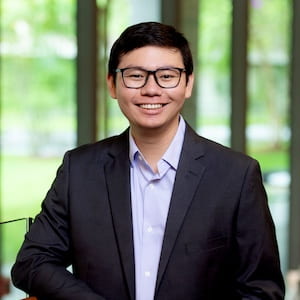 Arvin Soepriatna, Postdoctoral Fellow, Center for Biomedical Engineering
Arvin Soepriatna, Postdoctoral Fellow, Center for Biomedical Engineering
Abstract Title: Bioelectric Sutures Generated From hiPSC-derived Cardiomyocytes Enable In Vitro Electrical Coupling Between Engineered Cardiac Tissues
Abstract: Heart attack survivors live with permanent damage in their hearts and are at higher risk of developing heart failure. Current treatments do not directly repair or restore function in the damaged tissue. Implanting engineered cardiac tissues (ECTs) to restore contractility to the damaged myocardium is a promising therapy. However, this approach is challenged by poor integration between the implanted ECT and the host heart. To address this issue, we developed a bioelectric suture capable of propagating electrical signals to improve coupling between the two interfaces. We differentiated ventricular cardiomyocytes (CMs) from human induced pluripotent stem cells (hiPSCs) following a well-adopted small molecule modulation of the Wnt signaling pathway. Metabolic-based lactate purification was performed to increase CM purity to > 80%, evaluated by flow cytometry analysis of cardiac troponin-T. We constructed fibrin threads by coextruding fibrinogen and thrombin through a blending tip connector into a HEPES bath. Polymerized, stretched, and dried threads were coated in Matrigel, clamped to suture heads, and seeded with hiPSC-CMs mixed with 5% human ventricular cardiac fibroblasts at a density of 5×105 cells/cm for 72 hours. We cultured the conductive and contractile sutures for 2 weeks under 1Hz electrical stimulation. Optical mapping was performed to characterize electrical properties of bioelectric sutures, including action potential duration (APD) and conduction velocity (CV). Bioelectric sutures were electromechanically active with APD80 = 547 29 ms and CV = 25.1 5.9 mm/s. -actinin and connexin-43 staining revealed that hiPSC-CMs preferentially aligned with the thread and formed significant gap junctions, suggesting the formation of an electrical syncytium. Preliminary results and ongoing work showed that bioelectric sutures sutured to two separate ECTs electrically coupled within 3 days, enabling directed electrical propagation from one tissue to the other. Collectively, these results demonstrate that bioelectric sutures establish a CM bridge for electrical propagation, which may improve the integration of implanted ECTs with the host heart and enable the development of therapies to treat diseases of cardiac electrical conduction.
